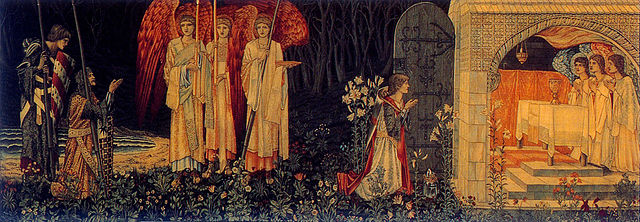BY DANIEL T. GOMES
AN EPIC ACCOUNT OF AN EQUALLY EPIC LEGEND
The epic retelling of the Arthurian legend in the form of Le Morte d’Arthur has immortalized not only its author, but the very legend of Arthur and his valiant Knights of the Round Table as well. It contains everything a great fiction book ought to have – adventure, love, chivalry, danger, betrayal and a sprinkle of magic – and as such Biblion is proud to honor one of the first and finest works to be printed in Great Britain.
Let us go back to a land of kings and queens, of mighty battles and jolly feasts; of knights both valorous and cunning, of lovers both faithful and treacherous. Let us go back to Camelot. Let us go back to the time of King Arthur.
Le Morte d’Arthur is an invaluable account of the adventures surrounding Arthur and his loyal knights, written by a mysterious Thomas Malory and published posthumously by the renowned printer William Caxton circa 1485. With an exceptional amount of detail, Malory’s masterpiece draws the reader to a mythical era, where fantasy and historicity blend seamlessly to produce a magnificent work of medieval fiction.
In this lengthy compilation of adventures and tales, we see the rise and fall of Arthur and everything in between. Malory depicts numerous events that have made the Arthurian legend so iconic, including Arthur’s retrieval of Excalibur, Guinevere’s affair with Lancelot and the quest for the Sangreal (Holy Grail). While much of the book surrounds the mythical King of Camelot, Malory writes extensively on characters both great and small; this is true with several of Arthur’s knights who play a more humble role in the king’s court but are well developed nonetheless. Their adventures are pivotal to the plot’s progress, which culminates in a great battle between Arthur and his “nephew,” the usurper Mordred.

Despite its many years, Le Morte d’Arthur remains an influential work as one of the foremost sources of Arthurian lore. It has shaped our perception of the legendary adventures surrounding the Knights of the Round Table and their king, and to a lesser yet still significant extent, it has had an impact on fantasy/historical fiction, the likes of which cannot be replicated. It is true the book has not aged all too well – its cadence and Middle English roots working together to make it feel detached from the contemporary reader – but with the right mindset, one can learn to enjoy Malory’s legacy and to see it as the classic of medieval literature it really is.
Cause and Effect
One of Malory’s most persistent motifs in Le Morte d’Arthur is the characters’ humanity. Although they are nobles called to uphold higher moral standards, the knights and ladies of the realm – including our most honorable King Arthur – are still human beings prone to act on their feelings and instincts. Yet these actions do not go unpunished, no matter who perpetrates them. Malory’s masterpiece is shaped by consequences to wrongdoing, and even the most chivalrous and pure can’t escape the rule. The affair between Guinevere and Lancelot creates a catastrophic rift between King Arthur and his beloved knight; Merlin’s lust for the Lady of the Lake ends with him trapped under a rock. Perhaps the most determining example of this is Arthur’s instance of accidental incest with his half-sister Morgause, which results in the birth of Mordred. Arthur tries to have Mordred killed right after his birth in Herodian style, but the baby survives and comes back several years later, infiltrating Arthur’s court and eventually usurping his father’s throne. Ultimately, Mordred is Arthur’s undoing, as the two clash in an epic final battle where Arthur kills his son, but not before the latter can mortally wound his incestuous father.
Cause and effect are the weavers of Malory’s tapestry, and they make a fine job at it too.
Ageing Like a Fine Wine… Right?
As soon as one starts reading Le Morte d’Arthur, one thing becomes evident: it sounds a bit stiff. Sentences just don’t seem to flow when the vast majority of them begins with “So,” “Then,” “And,” or a combination of these. It seems at times that Malory is more interested in laying out facts than in telling a story. These are all valuable points, and the following excerpt can certainly attest to that:
“Then within two years King Uther fell sick of a great malady. And in the meanwhile his enemies usurped upon him, and did a great battle upon his men, and slew many of his people. Sir, said Merlin, ye may not lie so as ye do, for ye must to the field though ye ride on an horse-litter: for ye shall never have the better of your enemies but if your person be there, and then shall ye have the victory. So it was done as Merlin had devised, and they carried the king forth in an horse-litter with a great host towards his enemies. And at St. Albans there met with the king a great host of the North. And that day Sir Ulfius and Sir Brastias did great deeds of arms, and King Uther’s men overcame the Northern battle and slew many people, and put the remnant to flight. And then the king returned unto London, and made great joy of his victory. And then he fell passing sore sick, so that three days and three nights he was speechless…”
Yet the modern reader can work around these points with a bit of imagination on his part. Let’s first address how Malory construes sentences. He does repeat a lot of the same conjunctions to provide a sense of continuity, and this could be held against him – but I would not do so, especially if there is a way to work around that. Something that worked for me was to imagine the actual narrator telling the story, as a grandparent tells stories to his grandchildren, or as friends tell stories to one another at a tavern (if we want to get medieval about it). Try reading the excerpt again with this in mind and see if it works for you too!
As to the view that Malory is laying out “facts,” it is actually quite the fair point. But perhaps that was Malory’s purpose: to make it look like these Arthurian myths are historically accurate. If you apply the narrator concept I just suggested to the idea that these tales are meant to sound real, the experience becomes even richer. You’re no longer reading some chopped retelling of legends and myths. You’re gathering a marvelous account of historical events surrounding Great Britain, as if Malory – or someone of your own choosing, for that matter – was sitting next to you, telling you all about how the king went to battle while still sick and stretched on a litter! See the difference?
Le Morte d’Arthur really has not aged too well, but it’s still proper for consumption – so long as we know how to take it in.

About the Author:
Daniel T. Gomes is a graphic designer and content writer from Lisbon, Portugal. He currently serves as Biblion’s Assistant Editor, having played a crucial role in the magazine since its inception. He is also a self-published author and one of the hosts of the biweekly Broklahomies Podcast.





